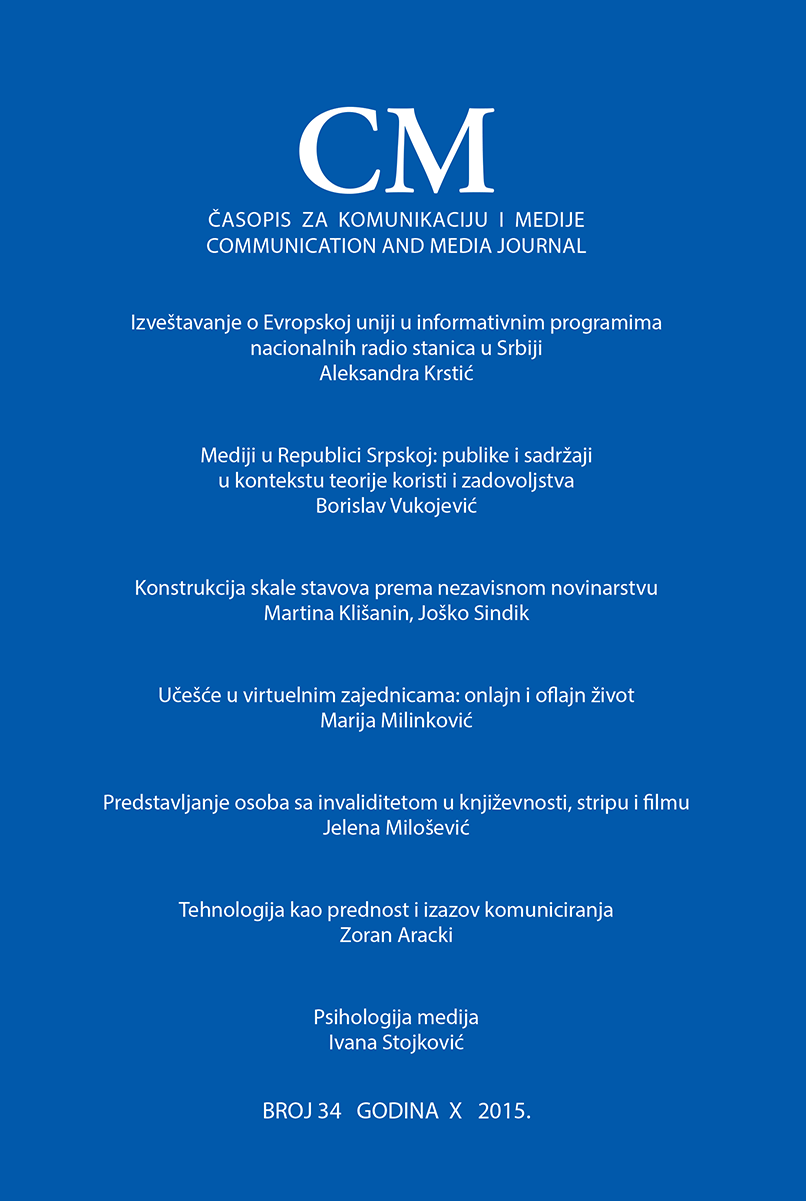The representation of persons with disabilities in literature, comic strip and film
Abstract
Exposed to discrimination, segregation and ghettoization, due to ignorance, superstition and fear of unknown, persons with disabilities were treated as a burden and later as patients in compliance with the medical model of disability for centuries. In the second half of the 20th century, under the influence of political and social changes and united activists with disabilities, the social model of disability, based on human rights that belong to everybody, as well as the language of disability have begun to develop. Human awareness has been one of the greatest obstacles on the road of these changes. Therefore, raising awareness is a continuous process requiring persistence, education and motivation of primarily persons with disabilities but the entire public too, with the compulsory usage of all forms of media. In this paper the analysis of films, books and strip whose characters are persons with disabilities indicates how the perception of the media, as a reflection of the society’s attitudes towards disability, has changed in time, from viewing persons with disabilities through the medical model of disability, as passive objects of other person's care, to observing disability from the human rights point of view and social model according to which disability is not a personal characteristic and individual problem, but a social phenomenon.
References
Andrić, I. (1988). Travnička hronika. Beograd: Prosveta.
Brown, C. (1998). My left foot. London: Vintage.
Centar za samostalni život invalida Srbije. (n.d.). Samostalni život je filozofija. Posećeno 1.9.2013. URL: http://www.cilsrbija.org/ser/static.php?id=vise.
Crnjanski, M. (1987). Seobe. Beograd: BIGZ.
Cucić, V. (2001). Osobe sa invaliditetom i okruženje. Beograd: Centar za proučavanje alternativa i Handicap International.
Estervic, I. (1995). Koncept samostalnog života. Posećeno 1.9.2013. URL: http://www.cilsrbija.org/ebib/Koncept%20samostalnog%20zivota.pdf .
Horwood, W. (1988). Skallagrigg. London: Penguin Books Ltd.
Hoseini, H. (2013). A planine odjeknuše. Beograd: Laguna.
Igo, V. (1977). Zvonar Bogorodičine crkve. Sarajevo: Svjetlost.
Jovanović, I. (2012). Naše reči odslikavaju naše stavove. U J. Trkulja (ur.), Zabrana diskriminacije osoba sa invaliditetom (str. 446-447). Beograd: Pravni fakultet Univerziteta, Nacionalna organizacija osoba sa invaliditetom Srbije, Službeni glasnik.
Kicinger, Dž. (2005). Dejstva i uticaji medija, Ponovo o uticaju medija: uvod u „nova istraživanja efekata medija“. U A. Bigs i P. Kobli (ur.), Uvod u studije medija (str. 415–429). Beograd: Clio.
Kovic, R. (2005). Born on the Fourth of July. New York. Akashic Books.
Leru, G. (2009). Fantom iz opere. Beograd: IPS Media [etc.].
Lorens, D. (2006). Ljubavnik Ledi Četerli. Beograd: Kompanija Novosti A.D.
Melvil, H. (1969). Mobi Dik. Beograd: Narodna knjiga.
Petrović, Lj. (2010). Jezik invalidnosti kao društveni problem kroz istoriju. Hereticus, 3-4: 75–90.
Stivenson, R. L. (1966). Ostrvo s blagom. Beograd: „Vuk Karadžić“.
Šapiro, Dž. P. (2005). Nema sažaljenja. Tuzla: IC za osobe sa invaliditetom „Lotos“.
Šekspir, V. (1966). Istorijske drame. Beograd: Kultura.
Tatić, D. (2011). Zaštita ljudskih prava osoba sa invaliditetom. Beograd: Službeni glasnik.
Vilijams, T. (2002). Staklena menažerija. Beograd: NNK-Internacional.
Copyright
Authors retain copyright of the published papers and grant to the publisher the non-exclusive right to publish the article, to be cited as its original publisher in case of reuse, and to distribute it in all forms and media.
Licensing
The published articles will be distributed under the Creative Commons Attribution ShareAlike 4.0 International license (CC BY-SA). It is allowed to copy and redistribute the material in any medium or format, and remix, transform, and build upon it for any purpose, even commercially, as long as appropriate credit is given to the original author(s), a link to the license is provided, it is indicated if changes were made and the new work is distributed under the same license as the original.
Users are required to provide full bibliographic description of the original publication (authors, article title, journal title, volume, issue, pages), as well as its DOI code. In electronic publishing, users are also required to link the content with both the original article published in CM: Communication and Media and the licence used.
Authors are able to enter into separate, additional contractual arrangements for the non-exclusive distribution of the journal's published version of the work (e.g., post it to an institutional repository or publish it in a book), with an acknowledgement of its initial publication in this journal.
Self-archiving policy
Authors are permitted to deposit author’s publisher's version (PDF) of their work in an institutional repository, subject-based repository, author's personal website (including social networking sites, such as ResearchGate, Academia.edu, etc.), at any time after publication.
Full bibliographic information (authors, article title, journal title, volume, issue, pages) about the original publication must be provided and links must be made to the article's DOI and the license.
Disclaimer
The views expressed in the published works do not express the views of the Editors and the Editorial Staff. The authors take legal and moral responsibility for the ideas expressed in the articles. Publisher shall have no liability in the event of issuance of any claims for damages. The Publisher will not be held legally responsible should there be any claims for compensation.

